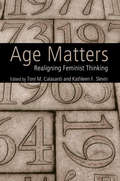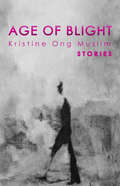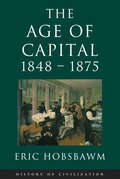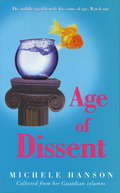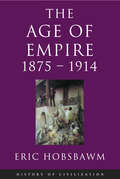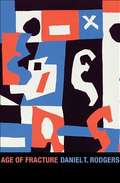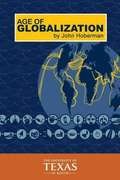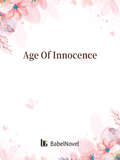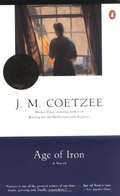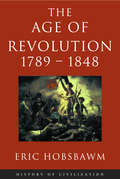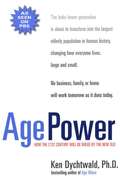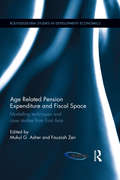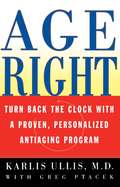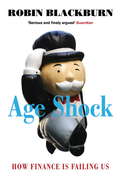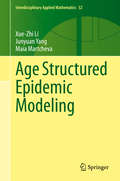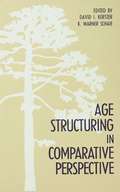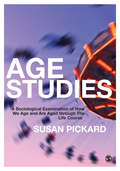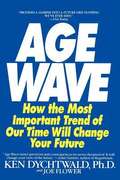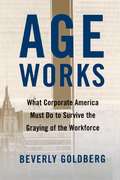- Table View
- List View
Age Matters: Re-Aligning Feminist Thinking
by Toni M. Calasanti Kathleen F. SlevinThis volume of original chapters is designed to bring attention to a neglected area of feminist scholarship - aging. After several decades of feminist studies we are now well informed of the complex ways that gender shapes the lives of women and men. Similarly, we know more about how gendered power relations interface with race and ethnicity, class and sexual orientation. Serious theorizing of old age and age relations to gender represents the next frontier of feminist scholarship. In this volume, leading national and international feminist scholars of aging take first steps in this direction, illuminating how age relations interact with other social inequalities, particularly gender. In doing so, the authors challenge and transform feminist scholarship and many taken for granted concepts in gender studies.
Age Of Blight: Stories
by Kristine Ong Muslim Alessandra HoganWhat if the end of man is not caused by some cataclysmic event, but by the nature of humans themselves? In Age of Blight, a young scientist's harsh and unnecessary experiments on monkeys are recorded for posterity; children are replaced by their doppelgangers, which emerge like flowers in their backyards; and two men standing on opposing cliff faces bear witness to each other's terrifying ends. Age of Blight explores a kind of post-future, in which the human race is finally abandoned to the end of its history. Muslim's poetic vignettes explore the nature of dystopia itself, often to darkly humorous effect, as when the spirit of Laika (the Russian space dog that perished on Sputnik 2) tries to befriend a satellite, or when Beth, the narrator's older sister, returns from the dead. The collection is illustrated throughout by the charcoal drawings of RISD artist Alessandra Hogan. In haunting and precise prose, Kristine Ong Muslim posits that humanity's downfall will be both easily preventable and terrifyingly inevitable, for it depends on only one thing: human nature.
Age Of Capital: 1848-1875
by Eric HobsbawmA magisterial account of the rise of capitalismEric Hobsbawm's magnificent treatment of the crucial years 1848-1875 is a penetrating analysis of the rise of capitalism and the consolidation of bourgeois culture. In the 1860s a new word entered the economic and political vocabulary of the world: 'capitalism'. The global triumph of capitalism is the major theme of history in the decades after 1848. The extension of capitalist economy to four corners of the globe, the mounting concentration of wealth, the migration of men, the domination of Europe and European culture made the third quarter of the nineteenth century a watershed. This is a history not only of Europe but of the world. Eric Hobsbawm's intention is not to summarise facts, but to draw facts together into a historical synthesis, to 'make sense of' the period, and to trace the roots of the present world back to it. He integrates economics with political and intellectual developments in this objective yet original account of revolution and the failure of revolution, of the cycles of boom and slump that characterise capitalist economies, of the victims and victors of the bourgeois ethos.
Age Of Capital: 1848-1875
by Prof Eric HobsbawmA magisterial account of the rise of capitalismEric Hobsbawm's magnificent treatment of the crucial years 1848-1875 is a penetrating analysis of the rise of capitalism and the consolidation of bourgeois culture. In the 1860s a new word entered the economic and political vocabulary of the world: 'capitalism'. The global triumph of capitalism is the major theme of history in the decades after 1848. The extension of capitalist economy to four corners of the globe, the mounting concentration of wealth, the migration of men, the domination of Europe and European culture made the third quarter of the nineteenth century a watershed. This is a history not only of Europe but of the world. Eric Hobsbawm's intention is not to summarise facts, but to draw facts together into a historical synthesis, to 'make sense of' the period, and to trace the roots of the present world back to it. He integrates economics with political and intellectual developments in this objective yet original account of revolution and the failure of revolution, of the cycles of boom and slump that characterise capitalist economies, of the victims and victors of the bourgeois ethos.
Age Of Dissent
by Michele HansonWhat does it feel like to be middle-aged? Twenty-seven in your own head, sixty-five in the mirror, ninety to your children and your mother still thinks you're twelve.Who is the chief dissenter among the three tall women who live noisily together under one roof: opinionated daughter, very opinionated elderly mother, or the poor beleaguered woman in between? Here in the middle we must carry on being reasonable, the cart horses of society, while everyone else the young and the old run amok. My mother grumps about in the garden, my daughter sobs upstairs. I find on these occasions I tend to play football with the dog. When one lives in a rather dramatic household, empty nest syndrome seems a delightful prospect . Known for her Treasure: The Teenage Terror books, Michele Hanson now collects her Age of Dissent Guardian columns. The middle-aged female has come of age. Watch out.
Age Of Dissent
by Michele HansonWhat does it feel like to be middle-aged? Twenty-seven in your own head, sixty-five in the mirror, ninety to your children and your mother still thinks you're twelve.Who is the chief dissenter among the three tall women who live noisily together under one roof: opinionated daughter, very opinionated elderly mother, or the poor beleaguered woman in between? Here in the middle we must carry on being reasonable, the cart horses of society, while everyone else the young and the old run amok. My mother grumps about in the garden, my daughter sobs upstairs. I find on these occasions I tend to play football with the dog. When one lives in a rather dramatic household, empty nest syndrome seems a delightful prospect . Known for her Treasure: The Teenage Terror books, Michele Hanson now collects her Age of Dissent Guardian columns. The middle-aged female has come of age. Watch out.
Age Of Empire: 1875-1914
by Eric HobsbawmTHE AGE OF EMPIRE is a book about the strange death of the nineteenth century, the world made by and for liberal middle classes in the name of universal progress and civilisation. It is about hopes realised which turned into fears: an era of unparalleled peace engendering an era of unparalleled war; revolt and revolution emerging on the outskirts of society; a time of profound identity crisis for bourgeois classes, among new and sudden mass labour movements which rejected capitalism and new middle classes which rejected liberalism. It is about world empires built and held with almost contemptuous ease by small bodies of Europeans which were to last barely a human lifetime, and a European domination of world history, which was never more confident than at the moment it was about to disappear for ever. It is about Queen Victoria, Madame Curie and the Kodak Girl, and the novel social world of cloth caps, golf clubs and brassieres, about Nietzsche, Carnegie, William Morris and Dreyfus, about politically ineffective terrorists, one of whom, to his and everyone's surprise, started a world war.With the AGE OF EMPIRE, Eric Hobsbawm, Britain's leading historian of the left, brings to a dazzling climax his brilliant interpretative history of 'the long nineteenth century'.
Age Of Empire: 1875-1914
by Prof Eric HobsbawmTHE AGE OF EMPIRE is a book about the strange death of the nineteenth century, the world made by and for liberal middle classes in the name of universal progress and civilisation. It is about hopes realised which turned into fears: an era of unparalleled peace engendering an era of unparalleled war; revolt and revolution emerging on the outskirts of society; a time of profound identity crisis for bourgeois classes, among new and sudden mass labour movements which rejected capitalism and new middle classes which rejected liberalism. It is about world empires built and held with almost contemptuous ease by small bodies of Europeans which were to last barely a human lifetime, and a European domination of world history, which was never more confident than at the moment it was about to disappear for ever. It is about Queen Victoria, Madame Curie and the Kodak Girl, and the novel social world of cloth caps, golf clubs and brassieres, about Nietzsche, Carnegie, William Morris and Dreyfus, about politically ineffective terrorists, one of whom, to his and everyone's surprise, started a world war.With the AGE OF EMPIRE, Eric Hobsbawm, Britain's leading historian of the left, brings to a dazzling climax his brilliant interpretative history of 'the long nineteenth century'.
Age Of Fracture
by Daniel T. RodgersIn the last quarter of the twentieth century, the ideas that most Americans lived by started to fragment. Mid-century concepts of national consensus, managed markets, gender and racial identities, citizen obligation, and historical memory became more fluid. Flexible markets pushed aside Keynesian macroeconomic structures. Racial and gender solidarity divided into multiple identities; community responsibility shrank to smaller circles. In this wide-ranging narrative, Daniel Rodgers shows how the collective purposes and meanings that had framed social debate became unhinged and uncertain. Age of Fracture offers a powerful reinterpretation of the ways in which the decades surrounding the 1980s changed America. Through a contagion of visions and metaphors, on both the intellectual right and the intellectual left, earlier notions of history and society that stressed solidity, collective institutions, and social circumstances gave way to a more individualized human nature that emphasized choice, agency, performance, and desire. On a broad canvas that includes Michel Foucault, Ronald Reagan, Judith Butler, Charles Murray, Jeffrey Sachs, and many more, Rodgers explains how structures of power came to seem less important than market choice and fluid selves. Cutting across the social and political arenas of late-twentieth-century life and thought, from economic theory and the culture wars to disputes over poverty, color-blindness, and sisterhood, Rodgers reveals how our categories of social reality have been fractured and destabilized. As we survey the intellectual wreckage of this war of ideas, we better understand the emergence of our present age of uncertainty.
Age Of Globalization
by John HobermanGlobalization is a fascinating spectacle that can be understood as global systems of competition and connectivity. These man-made systems provide transport, communication, governance, and entertainment on a global scale. International crime networks are also outgrowths of the same systems. In this course, you will learn how to identify and analyze global systems and better understand how they are changing societies around the world.
Age Of Innocence: Volume 1 (Volume 1 #1)
by ZhenyinfangThe Love, status and difference of several young people can't hinder the development of love. Xie Xiaomeng and Guodong, Letian and I, all of you have been very good friends. In fact, the heart of a simple man is very thin. The topic between a woman and a woman is always a man, and the topic between a man and a man is not necessarily a woman. A few years later, my home, Xie Xiaomeng and Zijing's home were very close. The appearance of four children increased the fun. I always thought that the happy day of not liking the wedding ended with a grand wedding. The appearance of my son Huatong and little guy also increased the fun of the wedding, which was no longer a form.
Age Of Iron
by J. M. CoetzeeFrom Publishers Weekly:<P> Harsh, unflinching and powerful, Coetzee's novel is a cry of moral outrage at the legacy that apartheid has created in South Africa. In scenes of stunning ferocity, he depicts the unequal warfare waging between the two races, a conflict in which the balance of power is slowly shifting.<P> An elderly woman's letters to her daughter in America make up the narrative. Near death from rapidly advancing cancer, Cape Town resident Mrs. Curren is a retired university professor and political liberal who has always considered herself a "good person" in deploring the government's obfuscatory and brutal policies, though she has been insulated from the barbarism they produce. When the teenage son of her housekeeper is murdered by the police and his activist friend is also shot by security forces, Mrs. Curren realizes that "now my eyes are open and I can never close them again."<P> The only person to whom she can communicate her anguished feelings of futility and waste is an alcoholic derelict whom she prevails on to be her messenger after her death, by mailing the packet of her letters to her daughter. In them she records the rising tide of militancy among young blacks; brave, defiant and vengeful, they are a generation whose hearts have turned to iron. His metaphors in service to a story that moves with the implacability of a nightmare, Coetzee's own urgent message has never been so cogently delivered.
Age Of Miracles
by John BrunnerWhen the aliens came to earth they did not make contact with its inhabitants. Instead they set up overnight, vast shining cities like mountainous gems whose borders men could not penetrate, where nations' bombs and weapons could do no damage. In the impact of these incredible invaders, the world's governments fell apart and new ganglike regimes arose. Reduced to helplessness on what was once their world, men struggle to find a different way of life... free of war, free of national enmities and united only by a burning desire to share in the interstellar Age of Miracles.
Age Of Revolution: 1789-1848
by Eric HobsbawmThe first in Eric Hobsbawm's dazzling trilogy on the history of the nineteenth century.Between 1789 and 1848 the world was transformed both by the French Revolution and also by the Industrial Revolution that originated in Britain. This 'Dual Revolution' created the modern world as we know it.Eric Hobsbawm traces with brilliant analytical clarity the transformation brought about in every sphere of European life by the Dual Revolution - in the conduct of war and diplomacy; in new industrial areas and on the land; among peasantry, bourgeoisie and aristocracy; in methods of government and of revolution; in science, philosophy and religion; in literature and the arts. But above all he sees this as the period when industrial capitalism established the domination over the rest of the world it was to hold for a century.Eric Hobsbawm's enthralling and original account is an impassioned but objective history of the most significant sixty years in the history of Europe.
Age Of Revolution: 1789-1848
by Prof Eric HobsbawmThe first in Eric Hobsbawm's dazzling trilogy on the history of the nineteenth century.Between 1789 and 1848 the world was transformed both by the French Revolution and also by the Industrial Revolution that originated in Britain. This 'Dual Revolution' created the modern world as we know it.Eric Hobsbawm traces with brilliant analytical clarity the transformation brought about in every sphere of European life by the Dual Revolution - in the conduct of war and diplomacy; in new industrial areas and on the land; among peasantry, bourgeoisie and aristocracy; in methods of government and of revolution; in science, philosophy and religion; in literature and the arts. But above all he sees this as the period when industrial capitalism established the domination over the rest of the world it was to hold for a century.Eric Hobsbawm's enthralling and original account is an impassioned but objective history of the most significant sixty years in the history of Europe.
Age Power: How the 21st Century Will Be Ruled By the New Old
by Ken DychtwaldIn this breakthrough book, Dychtwald explains how individuals, businesses, and governments can best prepare for a new era in which the priorities of our homes and nation will be set by the needs and desires of the elderly. He surveys how each of us must make individual decisions right now to "age-proof" our lives.
Age Related Pension Expenditure and Fiscal Space: Modelling techniques and case studies from East Asia (Routledge-ERIA Studies in Development Economics)
by Mukul G. Asher Fauziah ZenThis book explores the linkages between age-related pension expenditures and the fiscal space needed to fund them, as well as to organize the mix of financing methods with different risk-sharing arrangements. After critically assessing the existing models projecting age-related expenditure in the literature, the book focuses on the case studies of these inter-linkages in four highly-populated East Asian countries, namely China, Indonesia, India, and Japan. Nearly two- fifths of the global population live in these countries. Therefore, how these inter-linkages manifest themselves and the initiatives in these countries for finding fiscal space will have an impact on how the ageing issues are addressed globally. This book does several distinguishing characteristics, including exploration of inter-linkages between age-related expenditure and fiscal space, and application of country-specific methods to explore these linkages, rather than relying standard macroeconomic model. In the process, the studies also bring out the limitations of standardized model used in the literatures. Scholars and policy makers interested in the subject will definitely find the book of valuable use.
Age Right
by Greg Ptacek Karlis UllisWelcome to the new age in antiaging therapyDon't resign yourself to growing old gracefully. With Age Right as your guide, you can reduce body fat, increase strength and energy, and boost your sex drive, all while adding years to your life. With his revolutionary approach, Karlis Ullis, M.D,, provides you with the latest methods for stopping -- and even reversing -- the aging process. Based on twenty years of pioneering work with Olympic and professional athletes, Age Right offers an antiaging program that helps you extend your life span by identifying your unique aging pathway through the "Mind-Body-Spirit" test.USING A STEP-BY-STEP, PERSONALIZED PLAN OF EXERCISE, NUTRITION, AND ANTIAGING SUPPLEMENTS, THIS UNIQUE PROGRAM OFFERSThe most up-to-date information on how and why we age, and the four key factors in the aging processSelf-tests to determine your "biological age" (versus your chronological age)Expert advice on the best combination of nutrition, exercise, and supplements to fight the effects of age-related problems as indicated by your aging pathwaySpecific guidelines for modifying your antiaging regimen based on gender, fitness level, and lifestyleDetailed descriptions of all the antiaging supplements available today as well as treatments for the next millenniumPractical and extensive resources for choosing the right supplements, creating a specific diet and exercise plan, and finding the best antiaging health professionals
Age Right: Turn Back the Clock with a Proven, Personalized, Anti-Aging Program
by Greg Ptacek Karlis UllisWelcome to the new age in antiaging therapyDon't resign yourself to growing old gracefully. With Age Right as your guide, you can reduce body fat, increase strength and energy, and boost your sex drive, all while adding years to your life. With his revolutionary approach, Karlis Ullis, M.D,, provides you with the latest methods for stopping -- and even reversing -- the aging process. Based on twenty years of pioneering work with Olympic and professional athletes, Age Right offers an antiaging program that helps you extend your life span by identifying your unique aging pathway through the "Mind-Body-Spirit" test.USING A STEP-BY-STEP, PERSONALIZED PLAN OF EXERCISE, NUTRITION, AND ANTIAGING SUPPLEMENTS, THIS UNIQUE PROGRAM OFFERSThe most up-to-date information on how and why we age, and the four key factors in the aging processSelf-tests to determine your "biological age" (versus your chronological age)Expert advice on the best combination of nutrition, exercise, and supplements to fight the effects of age-related problems as indicated by your aging pathwaySpecific guidelines for modifying your antiaging regimen based on gender, fitness level, and lifestyleDetailed descriptions of all the antiaging supplements available today as well as treatments for the next millenniumPractical and extensive resources for choosing the right supplements, creating a specific diet and exercise plan, and finding the best antiaging health professionals
Age Shock
by Robin BlackburnMost countries face the future with an ageing population, yet most governments are cutting back on pensions and the care services needed by the elderly. Robin Blackburn exposes the perverse reasoning and special interests which have combined to produce this nonsensical state of affairs. This updated paperback edition of Age Shock includes a new preface explaining why the credit crunch and eurozone crisis have had such a devastating impact and outlining a way to guarantee decent pensions and care provision.
Age Structured Epidemic Modeling (Interdisciplinary Applied Mathematics #52)
by Maia Martcheva Xue-Zhi Li Junyuan YangThis book introduces advanced mathematical methods and techniques for analysis and simulation of models in mathematical epidemiology. Chronological age and class-age play an important role in the description of infectious diseases and this text provides the tools for the analysis of this type of partial differential equation models. This book presents general theoretical tools as well as large number of specific examples to guide the reader to develop their own tools that they may then apply to study structured models in mathematical epidemiology. The book will be a valuable addition to the arsenal of all researchers interested in developing theory or studying specific models with age structure.
Age Structuring in Comparative Perspective (Social Structure and Aging Series)
by David I. Kertzer K. Warner SchaieThis volume studies age as a basis for social organization by uniting research from the social science disciplines while implementing both cross-cultural and historical perspectives. The contributors, a distinguished interdisciplinary group of scholars, advance our understanding of age structuring by relating the changing societal level processes and individual aging experiences, and examining retirement practices, age and power in society, and cultural conceptions of age.
Age Studies: A Sociological Examination of How We Age and are Aged through the Life Course
by Dr Susan Pickard"With great rigour, yet an enviable lightness of touch, Susan Pickard has written an engaging and accessible book that students will love." - Rosaline Gill, City University London "A scholarly tour de force that brings into focus the various disciplines, histories, literatures and knowledges that have transformed us into modern subjects of age." - Stephen Katz, Trent University Age Studies takes an invigorating approach to the study of age and ageing in contemporary society. Encompassing ageing throughout the life course, taking in childhood, adolescence, mid-life and older age, and situated explicitly within a sociological disciplinary framework, Age Studies: Explores current social science debates on the study of ageing linking these to core sociological concepts. Links theory and application, using a variety of examples and international case studies Includes chapter summaries, further reading and guided questions. A thought-provoking companion to advanced undergraduates and postgraduate student studying ageing, older people, social gerontology and related courses.
Age Wave: The Challenges and Opportunities of an Aging America
by Ken Dychtwald Joe FlowerThis book, on aging, explores the profound effects our aging population, and the changing demographics that go with it, will have on every aspect of society, and on our personal plans and dreams for the future.
Age Works
by Beverly GoldbergIn ten years, the massive baby-boom generation will begin to reach retirement age, but few companies have paid attention to the fact that there are not enough younger workers to replace them. The challenge to corporate America, as Beverly Goldberg argues in Age Works, is to reinvent the workplace to make it better fit the needs of all employees, especially the older workers it must retain in order to thrive.
